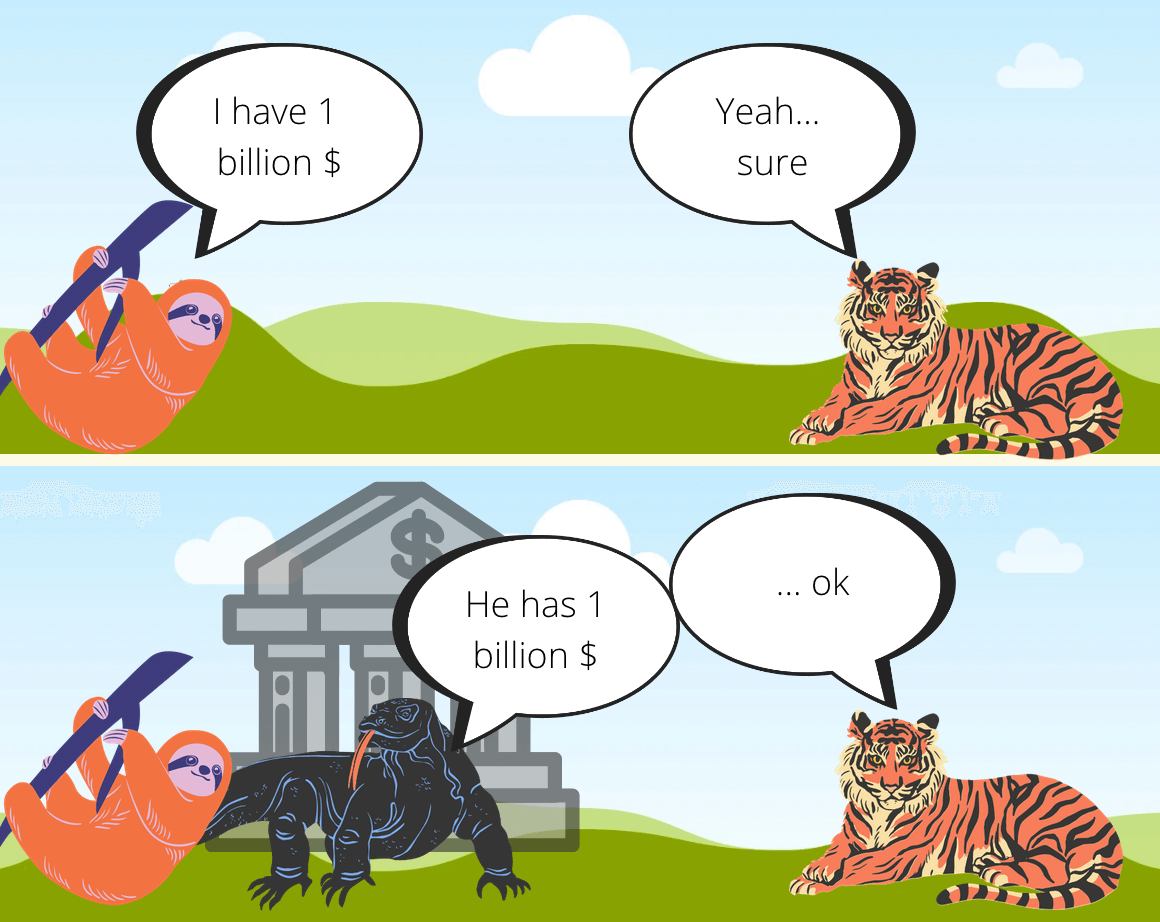Today the most popular concept related to NFT is “digital art”. The immediate spread of this application though created a false understanding that NFTs are just that: crypto + JPG.
This hides what they really are: a method to identify (and manage) a specific digital asset without the need of a third party.
Step 1 - Owership in the “real” world
Ownership and certification (intended as being able to prove and grant something) always needs someone or something whose purpose is to verify the legitimacy of the ownership claim.
If you (legally) own a car is because there is a registry and a document somewhere that acts as a source of truth.
The bank statement
If we meet and you say “I have 1 billion dollars”, what is the difference between the balance reported by the bank and your statement ?
The two statements are equally valid, but very few people will believe your statement unless the bank confirms it.
The bank acts as the source of truth for your balance.
This means that the money you own is certified by your bank: you can claim you have a certain balance only because the bank says so. If you want to buy something with your money, both you and the seller expect that money to be real and we rely on the bank to grant for that. We have an intermediary.
We know which statement to believe because our common knowledge give us the tools to differentiate them.
What about a contract between a buyer and a seller?
Let’s buy a house
Where I live, if you buy a house you MUST have a third party notary that will certify the change of ownership.
Let’s say I make a masterfully crafted copy of your house contract with my name on it.
Am I the owner of the house now ?
The answer is a simple no.
I may be able to convince another person without enough knowledge that I am the owner, but when the right knowledge and tools are used to check the authenticity, the fraud is discovered.
The notary has this knowledge and tools: when the contract was created between the buyer and the seller, the notary saved it “somewhere” that acts as a source of truth for the documents.
Whoever has this knowledge has the tools to compare the original contracts and the copy and identify which one is real and which one is not.
Again, in this example, we have an intermediary.
Knowledge and tools: let’s keep these concepts in mind for the next 5 minutes.
Step 2 - Ownership in the digital world
A definition of ownership is to “have the full and complete right of dominion over property”. It is different from possession: if you borrow my computer you have the possession, I still have the ownership.
How does this work in the digital world?
When we upload a content to a famous social network, we give them a:
… non-exclusive, transferable, sub-licensable, royalty-free and worldwide licence to host, use, distribute, modify, run, copy, publicly perform or display, translate and create derivative works of your content
We cannot request anything from the social, but they can sell it, modify it and basically do whatever they want. Also even if we delete the content, if it is already used by somebody else, they can still use it.
So: do we own those pictures? Wouldn’t it be nice to have control on them ? Maybe having a compensation if the social profit from it would be nice I guess.
What about a Netflix account? Netflix grants access to movies reproduction if you pay a subscription, and the service provider is also the entity that certify that you own an account.
Is this ownership ? Can you give it to somebody else ? grant to somebody else that you have a netflix account ?
Not really: Netflix gives you a user account whose only privilege is access to the service. You can’t sell it or demonstrate that you own it. You have possession.
Is there something online on which we have ownership ?
Before today there wasn’t the real necessity to have it: our ownerships always relied on an intermediary that grants it: the bank, paypal, etc.
If we want ownership we need to have knowledge and tools that demonstrate it.
Step 3 - Knowledge and tools
Given the previous examples, here’s some of the really strong features of NFTs:
Certification without an intermediary:
Since NFT creation and ownership management relies on blockchain technology, and since there is mathematical proof of how data is stored and considered unalterable, we can delegate the certification aspect to a software instead of a phisical intermediary.
Not only this, the software is decentralized (no single entity controls it) and distributed: there is no central node that can be taken down.
With a standardized method of control the role of the certifier is no longer necessary: a software and a mathematical proof grants that a content is not altered, and owned by someone.
Right management on data
Today we consider normal to give our service providers rights on our contents: we upload pictures, thoughts, but we don’t control it. It is very rare (and hard) to read the legal Terms of Use of the products we subscribe to, and this too gives the service providers the upper hand on how they really can use our content.
Having platforms that handles user generated content by leveraging NFT features gives final users the authority on the contents.
With infrastructure created in this direction we will have tools that allows users to directly control their data.
Conclusion
There are dozens of other fields where NFT can be used: some of them try to replicate patterns we already know but removing redundant roles.
Some other applications have the purpose to give finer logging and control over contents, and other application may grant privileges of access to services.
